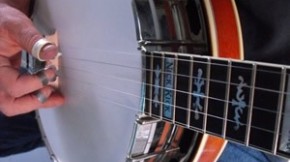Tips on Playing Banjo in a Jam
Tips on Playing Banjo in a Jam
By Ross Nickerson
It seems that when preparing for jam session or playing your banjo with other musicians that it is best to plan for the unexpected. One of the best ways to simplify the process is to learn to play song based on the chords only. In the real world of playing banjo with others or in a band, the first thing you learn are the chords to the song. Once you’ve understood the chord progression and arrangement, then you can begin to work on the finer points of the song such as the melody and creating a solo.
Learning how to improvise and “fill the space” based on the chord progression of the song is something that should and can be developed in practice. I recommend using backup play along CD or play along DVDs which is a great strategy for simulating a jamming situation. When practicing with backup tracks try to play along using only the chords to the song as your guide. Then practice all elements of the song, including rhythm vamping backup, simple picking backup and a lead break. Be sure to find some backup band tracks that play in other keys like C and D so you get lots of practice at that too. Learning to play melodies and basic improvisation out of the D “shape” is an important step in your progress in learning to play in other keys besides G or with a capo on. More information.
One of my DVDs called Playing Banjo By Ear and Learning the Chords covers improvising over chord progressions and playing songs based on the chords of the tune. Developing your skills in this area is essential in learning to play songs you don’t know on the fly. It’s not hard to pick up the chords especially when many of the songs played at jams are only three chords and become predictable. Knowing how to “fake” your way through songs you don’t know is how it’s done. We all do it, there are just different levels of how well we cover what is not expected or planned out ahead of time.
Here are some quick tips
Learning how to tune quickly is very helpful at jams. Practice taking the capo on and off and experiment with how your banjo reacts to the capo, teaching yourself how to get your banjo in tune quickly and QUIETLY. Turn away from others when tuning, and use your bare finger to pluck the string. Choose a banjo capo that requires the least amount of retuning. Less pressure and snug up against the fret wire works for me. Capos
Practicing dynamics at home by picking loud and soft trying to cover the whole volume spectrum is very helpful. Sometimes jamming etiquette is simply being able to play good banjo without drowning others out. Dynamics are also very useful in backup or when its your turn to solo. I cover this in my book The Banjo Encyclopedia “Bluegrass Banjo from A to Z” along with many other things that will help you learning to play with others on your banjo
Being able to keep up with faster tempos is an important but sometimes overlooked skill to develop in practice. It’s not necessary to burn the doors off but being left behind in even moderate tempos is an awful feeling for students. One quick tip is to keep what you play simple and have at least a couple of banjo rolls you can play at a faster speed. This will get you feeling the rhythm at a faster tempo and then you can introduce more complicated things later, especially with the fretting hand. This covers the subject much more in depth.
Resources for Playing Banjo in a Jam Session
Playing Banjo in Different Keys
Bluegrass Band Backup Play Along Tracks
Bluegrass Jamming Essentials DVD
The Banjo Encyclopedia “Bluegrass Banjo from A to Z”









